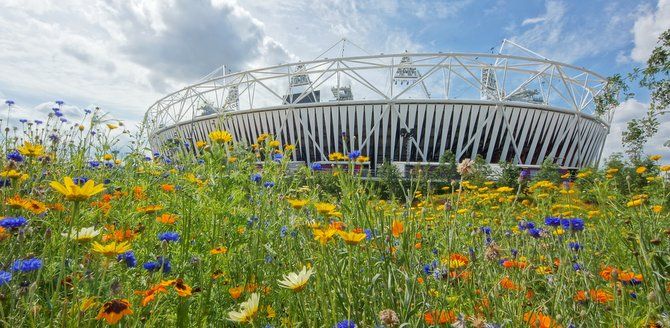Deputy editor, Tim Godfrey Twiss, attemtps to measure the impact his week of sporting activity has on the environment.
It is Epigreen week: what a fantastic way of raising awareness about our environment and encouraging people everywhere to live more sustainable lives. However, at Epigram Sport we were sat twiddling our thumbs trying to think of how to give sport a twist of green environmentalism. On the surface there isn’t much you can publish apart from a headline stating: “MOTORSPORT IS BAD – CARS GO FAST LOTS OF PETROL INNIT”. But when you dig deeper into the relationship between sport and the environment you realise that much of sport, like any aspect of human life, dramatically affects the planet. From the building of stadiums, to mass travel for tournaments to industrial construction of equipment, sport is without doubt adding to the environmental changes we are only beginning to experience as a species.
This article is not meant to be a damning criticism of the Olympics and the amount of air miles the athletes must travel, nor is it a high-horse shaming of any persons who currently aren’t protesting the blatant disregard for human rights in Qatar leading towards the 2022 World Cup - I don’t personally believe this type of large-scale rhetoric aids the changing of opinions for the average sportsperson.
I don’t expect you to go and tear down Wembley stadium and replace it with a mini wildlife sanctuary with the word ‘eco-terrorist’ tattooed on your head.
Eventually, I think that as a community sports will shift towards a greener way of operating, just as every aspect of human life will do, but for now I don’t expect you to go and tear down Wembley stadium and replace it with a mini wildlife sanctuary with the word ‘eco-terrorist’ tattooed on your head. Instead I want anyone reading this to just consider how their involvement of sports does affect the environment – whether positively or negatively on a personal level.
To investigate sporting impact by a normal sportsperson, I have taken an average week of sport for me and have deconstructed what I do in terms of environmental impact. This list will be in no way conclusive and therefore not scientifically accurate, but it will serve to illustrate how things we consider to be inherently ‘good’ for us like going for a run actually has repercussions we cannot instantly see. Now, I recognise this sounds like the worst pre-drinks game ever created but hopefully the exercise should reveal some interesting realities.
Monday- Gym for 1h 20 minutes.
Firstly, I used the weight machines. Steel can cost 1.6 tonnes of CO2 per tonne steel (this is the value that Korea and Mexico currently manufacture steel at, the US and most of Asia is more, some countries produce it at less but as I am not taking into account the carbon emissions of transporting the raw steel to the factory where it is turned into a gym machine I will assume the steel I used was not created in the most efficient way). I used 14 machines, which is approx. 1.8 tonnes so through that one can assume that 2.88 tonnes of CO2 was produced for just the machines I used. Now obviously many thousands of people share this CO2 load but what not everyone shared was the 20 minute run at 16 km/h on the treadmill.
The treadmill used a 2200W motor, but probably wasn’t using its maximum power output as I was not running at its max velocity. However, I was running at 72% of its maximum velocity so I can assume it ran at least 1584W (probably more as the motor becomes more inefficient as it works harder and heats up etc). I also ran for 20 minutes so 1/3 of an hour. 1584/3 = 528 so 0.528 kW/h. To produce 0.528kW/h through burning coal there will also be 0.5kg of CO2 produced. It is probably safe to assume the electricity used wasn’t produced through coal burning but the actual value of CO2 I produced is still highly likely to be more than 100 grams. This may not sound a lot but I run around three times a week on a treadmill which means that in a year I’m personally contributing 15.6 kg of CO2 to the atmosphere just by being a nice healthy boy and going for a run.
Temperatures may be dropping this week with #uksnow, but there are some parkrunners who don't mind the cold...
— parkrun UK (@parkrunUK) February 26, 2018
Amongst the parkrun family, there are:
❄️ 754 Frosts
☃️ 207 Snows
🌨️ 13 Blizzards
🌳 #loveparkrun pic.twitter.com/c9pBRLXQn8
Tuesday - Hill sprints
When planning this weird doomsday diary, I thought that this would be one of the more ‘green’ days. The hill was a natural grass one, no production there. I didn’t even use a phone to listen to music. However, I did use my football boots for grip. My boots are Nike Mercurials from about two years ago (anyone who has played against me on the Downs on a Wednesday are sure to have flashbacks of a lanky freak drifting effortlessly past defences wearing them). They were actually not from Nike but from a rogue seller on AliBaba, this means they were from China and they were sent via plane for speed. The plane journey which my boots were involved in meant that 0.65 tonnes of CO2 entered the atmosphere. My poor old boots weren’t entirely to blame but even if the plane was carrying 10,000 pairs of boots for other bang average players in the UK my decision to buy said boots resulted in 65 grams of CO2 being added to the environment – even before calculating the construction costs of the boots.
Wednesday - Intramural football
We have discussed my evil boots which were also worn on this day, but the real environmental cost here is sporting equipment, the most I use all week. Firstly, there is the football and the kit. A set of kits made from polyester maybe weighs 2kg. The ball is produced synthetically using petrochemicals that are derived from the extraction of oil, unfortunately I have neither the time nor intimate understanding of chemistry to guess at the negative effects of the ball on the environment. However, 2kg of polyester emits 19 grams of CO2 into the atmosphere throughout its production so the kits most teams wear are by no means ‘green’.
As anyone who plays intramural football knows, two tractors assemble and disassemble all goals on the downs. We can call this one tractor, but assumes it travels twice as far (for the ease of calculation). Sadly, I don’t know where the tractor(s) begins its journey but its route around the Downs is approx four miles as it has to jack-knife up and down the pitches. An average tractor mpg is six. So, for one day of intramural the tractor(s) will use 2/3 of a gallon of probably diesel, which is three litres. This results in 8kg of CO2 being produced by the tractors just for intramural to take place, let alone the negative effects of refining diesel.
Thursday - Gym for 1h
Once again, everything I did on Monday applies. But on this day, I took the lift five floors up, when I could have taken the stairs. This decision meant that an extra 0.2kg of carbon emissions went into the atmosphere. I think this example is indicative of how I could easily become greener during sport – taking the stairs is better for me and the environment.
Friday - Went to Airhop
I took the bus there (seven miles) and the double decker I went on had an mpg of six. This meant 1.16 gallons, however this was split between 49 passengers (I checked) so 1.16 gallons of diesel between 49 is 0.023 gallons so by me taking the bus 0.23kg of CO2 was produced. I know that the bus service wasn’t my personal bounce-mobile, there were others taking it and the service would have run regardless, but if half the people on the bus cycled then there would be a significant drop in frequency of bus services.
Say the hall was heated from 10am to 2pm then the heaters have generated 74243 in 4 hours, or 14,400 seconds meaning the heaters worked at 5.15W for 4 hours – just to heat a hall for football.
Saturday - Indoor football
I went and played futsal in a sports hall that had rough dimensions of 40m x 25m x 15m. The air temperature that day was eight degrees Celsius, but let’s say the hall had kept a residual heat of 14 degree Celsius from the day before. The temperature within the hall when I arrived was around 18/19 degrees Celsius – this meant the hall was heated by at least four temperature units (those budding scientists among us will know the unit doesn’t matter for what we’re about to do). So, the volume of the hall is 15000m3 and the density of air is 1.23kg/m3 the total mass of the air in the hall was 18450kg. So, the energy required to heat the air by 4 temperature units is: 1.006 (specific heat capacity of air) x 18450 x 4 = 74243 joules. Say the hall was heated from 10am to 2pm then the heaters have generated 74243 in 4 hours, or 14,400 seconds meaning the heaters worked at 5.15W for 4 hours – just to heat a hall for football.
Sunday - Cliff jumping
I drove from Bristol to Minions in Cornwall to throw myself off a cliff – luckily gravity provides the acceleration of me falling so no need to work that out. However, the 220 mile round trip in my 1.6 litre diesel car did produce CO2 emissions. The journey produced 30kg of CO2 and in reality it was not a trip I necessarily needed to take.
This exercise is not meant to persuade people to not take part in sport but I do want people to acknowledge that sport does have drawbacks when considering the environment and how green you are.
Well that’s the end of my diary. The diary is by no means complete, or scientifically accurate, however, I have often underestimated energy used or CO2 produced in an attempt to not make outrageous claims. This exercise is not meant to persuade people to not take part in sport but I do want people to acknowledge that sport does have drawbacks when considering the environment and how green you are. Just like in any other aspect of your life there are things you can cut back on, or decisions you can make to help the environment even if it is just a miniscule amount.
Featured Image: Flickr / Daniel Coomber









